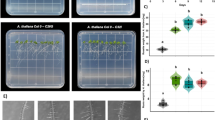Summary.
Larvae of the turnip sawfly, Athalia rosae L. (Hymenoptera: Tenthredinidae), sequester glucosinolates of their host plants, namely members of the Brassicaceae family, in their haemolymph. Therefore, they need to circumvent myrosinase activities of the plant tissue which normally hydrolyse the glucosinolates after plant damage. Effects of varying levels of glucosinolates and myrosinases on the performance of A. rosae were investigated using homozygous lines of Brassica juncea (L.) with either (1) low glucosinolate (lowGS) and low myrosinase (lowMR), (2) high glucosinolate (highGS) and high myrosinase (highMR), or (3) high glucosinolate (highGS) and low myrosinase (lowMR) levels. To insure that the given quantities remained as constant as possible, newly hatched larvae were enclosed on the second-youngest leaf of a plant, and were offered a new plant of comparable physiological age (6-leaf-stage) every day. The performance of A. rosae was little affected by leaf quality. Body masses of eonymphs and adults were on average lowest on the highGS/highMR-line, but these differences were rarely significant. The pupal developmental times of females and males were longest on the highGS/lowMR-line in only one of two replicate experiments. All other performance traits (developmental times of larvae, egg numbers, adult longevity) were not significantly different. Glucosinolates, sequestered by the larvae, are carried through the pupal stage. The glucosinolate concentration measured in adult insects reflected the level of the host plant line, without showing any obvious costs for sequestration. Obviously, A. rosae is highly tolerant to variation in the glucosinolate-myrosinase system of its host.
In addition, induced changes of glucosinolate concentrations and myrosinase activities caused by 24 h-feeding of groups of three small larvae were analysed in the second-youngest leaves. In contrast to the patterns most herbivores evoke on Brassicaceae, namely an increase of both glucosinolate concentration and myrosinase activity, we detected a significant decrease of both traits in all three lines where the respective trait was originally high in the plants. Although glucosinolate levels dropped in the highGS lines about 50%, these still contained higher concentrations than the lowGS line. Whereas the activity of soluble myrosinases remained highest in the highMR line, even after a decrease to almost 30% due to feeding, the levels of insoluble myrosinases converged after feeding in lowMR and highMR lines. Levels of the signalling molecule salicylic acid slightly decreased on average after feeding, whereas jasmonic acid was below the detection threshold in almost all samples. The concentration of several molecules varies strongly in plant tissue with age and can change due to induction by herbivore feeding. Therefore, if performance of an insect species is measured on plants with specific traits, the variability in these traits needs to be carefully controlled in experiments.
Similar content being viewed by others
Author information
Authors and Affiliations
Corresponding author
Rights and permissions
About this article
Cite this article
Müller, C., Sieling, N. Effects of glucosinolate and myrosinase levels in Brassica juncea on a glucosinolate-sequestering herbivore – and vice versa. Chemoecology 16, 191–201 (2006). https://doi.org/10.1007/s00049-006-0347-7
Received:
Accepted:
Published:
Issue Date:
DOI: https://doi.org/10.1007/s00049-006-0347-7




